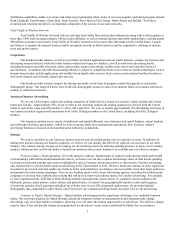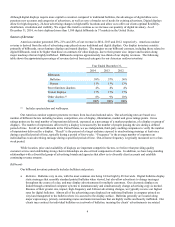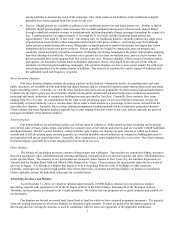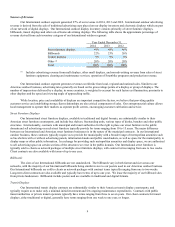iHeartMedia 2014 Annual Report Download - page 17
Download and view the complete annual report
Please find page 17 of the 2014 iHeartMedia annual report below. You can navigate through the pages in the report by either clicking on the pages listed below, or by using the keyword search tool below to find specific information within the annual report.15
U.S. federal law neither requires nor prohibits the removal of existing lawful billboards, but it does mandate the payment of
compensation if a state or political subdivision compels the removal of a lawful billboard along the controlled roads. In the past, state
governments have purchased and removed existing lawful billboards for beautification purposes using federal funding for
transportation enhancement programs, and these jurisdictions may continue to do so in the future. From time to time, state and local
government authorities use the power of eminent domain and amortization to remove billboards. Thus far, we have been able to
obtain satisfactory compensation for, or relocation of, our billboards purchased or removed as a result of these types of governmental
action, although there is no assurance that this will continue to be the case in the future.
We have introduced and intend to expand the deployment of digital billboards that display static digital advertising copy from
various advertisers that change up to several times per minute. We have encountered some existing regulations in the U.S. and across
some international jurisdictions that restrict or prohibit these types of digital displays. However, since digital technology for changing
static copy has only recently been developed and introduced into the market on a large scale, and is in the process of being introduced
more broadly in our international markets, existing regulations that currently do not apply to digital technology by their terms could be
revised to impose greater restrictions. These regulations, or actions by third parties, may impose greater restrictions on digital
billboards due to alleged concerns over aesthetics or driver safety.
ITEM 1A. RISK FACTORS
Risks Related to Our Business
Our results have been in the past, and could be in the future, adversely affected by economic uncertainty or deteriorations in
economic conditions
We derive revenues from the sale of advertising. Expenditures by advertisers tend to be cyclical, reflecting economic
conditions and budgeting and buying patterns. Periods of a slowing economy or recession, or periods of economic uncertainty, may
be accompanied by a decrease in advertising. For example, the global economic downturn that began in 2008 resulted in a decline in
advertising and marketing by our customers, which resulted in a decline in advertising revenues across our businesses. This reduction
in advertising revenues had an adverse effect on our revenue, profit margins, cash flow and liquidity. Global economic conditions
have been slow to recover and remain uncertain. If economic conditions do not continue to improve, economic uncertainty increases
or economic conditions deteriorate again, global economic conditions may once again adversely impact our revenue, profit margins,
cash flow and liquidity. Furthermore, because a significant portion of our revenue is derived from local advertisers, our ability to
generate revenues in specific markets is directly affected by local and regional conditions, and unfavorable regional economic
conditions also may adversely impact our results. In addition, even in the absence of a downturn in general economic conditions, an
individual business sector or market may experience a downturn, causing it to reduce its advertising expenditures, which also may
adversely impact our results.
We performed impairment tests on our goodwill and other intangible assets during the fourth quarter of 2014, 2013 and 2012
and recorded non-cash impairment charges of $19.2 million, $17.0 million and $37.7 million, respectively. Although we believe we
have made reasonable estimates and used appropriate assumptions to calculate the fair value of our licenses, billboard permits and
reporting units, it is possible a material change could occur. If actual market conditions and operational performance for the
respective reporting units underlying the intangible assets were to deteriorate, or if facts and circumstances change that would more
likely than not reduce the estimated fair value of the indefinite-lived assets or goodwill for these reporting units below their adjusted
carrying amounts, we may also be required to recognize additional impairment charges in future periods, which could have a material
impact on our financial condition and results of operations.
To service our debt obligations and to fund capital expenditures, we will require a significant amount of cash to meet our needs,
which depends on many factors beyond our control
Our ability to service our debt obligations and to fund capital expenditures will require a significant amount of cash. Our
primary source of liquidity is cash on hand, cash flow from operations and borrowing capacity under our receivables based credit
facility, subject to certain limitations contained in our material financing agreements. Based on our current and anticipated levels of
operations and conditions in our markets, we believe that cash on hand, cash flow from operations, borrowing capacity under our
receivables based credit facility and cash flow from other liquidity-generating transactions will enable us to meet our working capital,
capital expenditure, debt service and other funding requirements for at least the next twelve months. However, our ability to fund our
working capital, capital expenditures, debt service and other obligations, and to comply with the financial covenant under our
financing agreements, depends on our future operating performance and cash from operations and other liquidity-generating
transactions, which are in turn subject to prevailing economic conditions and other factors, many of which are beyond our control. If
our future operating performance does not meet our expectation or our plans materially change in an adverse manner or prove to be
materially inaccurate, we may need additional financing. In addition, the purchase price of possible acquisitions, capital expenditures
for deployment of digital billboards and/or other strategic initiatives could require additional indebtedness or equity financing on our
























